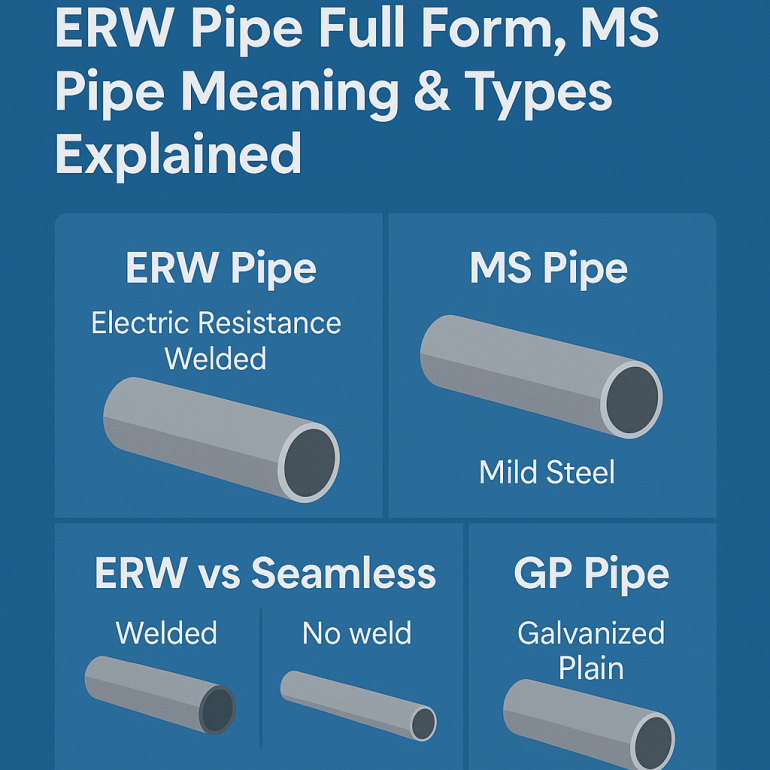ERW Pipe, MS Pipe Full Form & Uses | Mild Steel Guide

ERW Pipe Full Form, MS Pipe Meaning & Types Explained
1. Introduction
In industrial construction and manufacturing, understanding the terminology around steel pipes is crucial. Terms like ERW, MS, GP, and mild steel are often used interchangeably, but they each have specific meanings. This guide breaks down the full forms, applications, and differences between these common steel pipe types.
2. What is ERW Pipe?
ERW Pipe Full Form: Electric Resistance Welded Pipe
Definition: ERW pipes are steel pipes manufactured using electric resistance welding. The steel strip is shaped into a cylindrical form and then welded longitudinally using electric resistance—no filler material is used.
- Smooth internal surface
- High dimensional accuracy
- Cost-effective for medium and high-pressure applications
Common Uses: Water pipelines, scaffolding, fencing, structural steel applications
3. ERW Full Form in Steel Industry
Even when used alone, ERW still refers to Electric Resistance Welded. It is a specific method of joining metal without any welding rods. The term is widely recognized in steel fabrication and pipe manufacturing industries.
4. What is MS Pipe?
MS Pipe Full Form: Mild Steel Pipe
Definition: MS pipes are made from low-carbon steel (mild steel). They are easy to weld, shape, and work with, making them suitable for a variety of low-pressure applications.
- Affordable and widely available
- Easy to fabricate and customize
- Lower strength compared to high-carbon steel but sufficient for many uses
Applications: Water transportation, general engineering, fencing and furniture
5. MS ERW Pipe – What Does It Mean?
When you see the term MS ERW Pipe, it combines both:
- MS (Mild Steel) as the material
- ERW (Electric Resistance Welding) as the manufacturing process
This means it’s a mild steel pipe made using the ERW process—ideal for structural or plumbing use where weld strength is crucial.
6. ERW Pipe vs Seamless Pipe – Key Difference
| Feature | ERW Pipe | Seamless Pipe |
|---|---|---|
| Manufacturing | Welded using resistance | Made without any welding |
| Cost | Cheaper | More expensive |
| Applications | Structural, general purpose | High-pressure, precision required |
| Surface | Visible weld line | Smooth all over |
7. What is GP Pipe?
GP Pipe Full Form: Galvanized Plain Pipe
Definition: GP pipes are mild steel pipes that are electro-galvanized (zinc coated). They have a shiny surface and are corrosion-resistant.
Best Used For: Fencing and gates, household water lines, industrial ventilation and piping systems
8. ERW Tube vs ERW Pipe
While often used interchangeably, there's a slight difference:
- ERW Tube typically refers to precision structural applications
- ERW Pipe is usually used in plumbing, scaffolding, and water delivery
9. MS Full Form in Steel Industry
Beyond pipes, MS (Mild Steel) is used in various forms:
- Sheets
- Rods
- Beams
- Flats
Its full form remains Mild Steel, and it’s the foundation material for many structural steel products.
10. Mild Steel Pipe – Use Cases
Mild Steel Pipes are commonly used in:
- Mechanical and general engineering
- Domestic water supply
- Firefighting systems
- Industrial piping frameworks
11. FAQs
Q1. What is specification for ERW MS pipes?
A: ERW MS pipes are specified based on outer diameter, wall thickness, length, and IS/ASTM standards. Common specifications include IS 1239, IS 3589, and ASTM A53 depending on the application.
Q2. What are MS ERW pipes?
A: MS ERW pipes are mild steel pipes produced using Electric Resistance Welding. They offer strength, weldability, and affordability for structural and plumbing use.
Q3. What is ERW MS pipe?
A: ERW MS pipe refers to Electric Resistance Welded pipe made from mild steel. It combines the benefits of low-carbon steel with a strong weld seam suitable for a wide range of applications.
12. Conclusion
Understanding terms like ERW, MS, and GP helps in making informed decisions in construction, plumbing, or industrial projects. Whether you’re sourcing material or learning about steel types, this guide simplifies industry jargon into clear definitions and comparisons.









Comments : 0